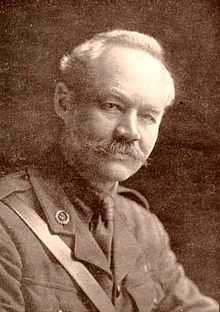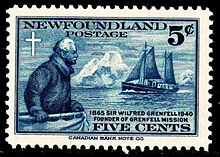Wilfred Grenfell


Sir Wilfred Thomason Grenfell, KCMG (28 February 1865 – 9 October 1940) was a medical missionary to Newfoundland and Labrador.[1]
Biography
He was born at Parkgate, Neston, Wirral, England, the son of Rev. Algernon Sidney Grenfell,[2] headmaster of Mostyn House School, and Jane Georgiana Hutchison.
Grenfell moved to London in 1882. He then commenced the study of medicine at the London Hospital Medical College (now part of Barts and The London School of Medicine and Dentistry) under the tutelage of Sir Frederick Treves: he graduated in 1888.
The Royal National Mission to Deep Sea Fishermen sent Grenfell to Newfoundland in 1892 to improve the plight of coastal inhabitants and fishermen.[3] That mission began in earnest in 1893 when he recruited two nurses and two doctors for hospitals at Indian Harbour, Newfoundland and later opened cottage hospitals along the coast of Labrador.The mission expanded greatly from its initial mandate to one of developing schools, an orphanage, cooperatives, industrial work projects, and social work. Although originally founded to serve the local area, the mission developed to include the aboriginal peoples and settlers along the coasts of Labrador and the eastern side of the Great Northern Peninsula of northern Newfoundland. For his years of service on behalf of the people of these communities he was later knighted.
He married Anne Elizabeth Caldwell MacClanahan (?-1938) of Chicago, Illinois, in 1909. They had three children and retired to Vermont after his work in Newfoundland.
Grenfell died of a coronary thrombosis at Kinloch House in Charlotte, Vermont on 9 October 1940.[1] His ashes were brought to St Anthony, where they were placed inside a rock face overlooking the harbour.
Introduction of reindeer
In 1907 Grenfell imported a group of 300 reindeer from Norway to provide food and serve as draft animals in Newfoundland. Unbeknownst to him, some of the animals carried a parasitic roundworm, Elaphostrongylus rangiferi, that then spread to native caribou herds. The reindeer herd eventually disappeared; however, the parasite took hold and causes cerebrospinal elaphostrongylosis (CSE) in caribou, a disease well known in reindeer in Scandinavia.[4]
International Grenfell Association
By 1914 the mission had gained international status. In order to manage its property and affairs, the International Grenfell Association, a non-profit mission society, was founded to support Grenfell's work. The Association operated, until 1981, as an NGO. It had responsibility for delivery of healthcare and social services in northern Newfoundland and Labrador. After 1981 a governmental agency, The Grenfell Regional Health Services Board, took over the operational responsibility. The International Grenfell Association, having divested itself of all properties and operational responsibility for health and social services, boarding schools, hospitals then became a supporting association making grants and funding scholarships for medical training.
Historical Society

The Sir Wilfred Thomason Grenfell Historical Society was formed in 1978. The society purchased Grenfell's home in St. Anthony, Newfoundland and Labrador. The home has been restored as a museum and archives. The Sir Wilfred Thomason Grenfell Historical Society with the support of Provincial Government and the International Grenfell Association began construction of an interpretation centre in St. Anthony and it was opened in 1997. This facility added to the existing house and serves to promote the legacy to thousands of visitors each year. The Grenfell Interpretation Centre also is used by other organizations for meetings and events. A large interpretive display is housed there and provides historical background surrounding the work of Sir Wilfred Thomason Grenfell.
Literary inspiration
A unique figure, Grenfell served to inspire at least two characters in Canadian literature: Dr. Luke in Norman Duncan's Doctor Luke of the Labrador (1904) and Dr. Tocsin in White Eskimo by Harold Horwood (1972).
A biography for children (middle-high school) was written in 1942, by Genevieve Fox. Published by Thomas Y. Crowell Co. The book had second and third printings as well.
The following statement has been widely ascribed to him, but cannot be found in any of his books: "The service we render to others is really the rent we pay for our room on this earth. It is obvious that man is himself a traveler; that the purpose of this world is not 'to have and to hold' but 'to give and serve.' There can be no other meaning."
Grenfell Cloth
Grenfell named a 600 thread-per-inch woven Egyptian cotton material 'Grenfell Cloth' created for him by Walter Haythornthwaite.[5]
Veneration
Grenfell is honoured with a feast day on the liturgical calendar of the Episcopal Church (USA) on October 9.
Awards
- Companion of the Most Distinguished Order of St. Michael and St. George - 1907
- Honorary Doctorate of Medicine, University of Oxford – 1907 (first ever granted)
- Murchison Prize, Royal Geographical Society - 1911 (awarded for his charts of Labrador)
- Knighthood - 1927 (recognition of medical, educational and social work)
- Honorary Knight for Life, Loyal Knights of the Round Table, Fifth Rank - 1928 (for great service to humanity)
- Induction into the Canadian Medical Hall of Fame - 1997
In 1979, the Corner Brook campus of Memorial University of Newfoundland was renamed Sir Wilfred Grenfell College in his honour. In 2010, following a debate to rename this campus, the name Grenfell Campus, Memorial University of Newfoundland was chosen, to reflect the campus' ties to the spirit of Sir Wilfred Grenfell's legacy.
Publications
Books by Grenfell include:
- A Labrador Doctor
- Labrador Days
- Tales of the Labrador
- The Adventure of Life
- Adrift on an Ice-Pan
- What the Bible Means to Me
- What Christ Means to Me
- What the Church Means to Me
- Yourself and Your Body (Scribner's, New York, 1928, written at the time when he said his two sons had just reached the age of ten million Whys? and Hows?)
- "Down North on the Labrador"
See also
- Grenfell Campus, Memorial University of Newfoundland
- International Grenfell Association
References
- ↑ 1.0 1.1 "Wilfred Grenfell Of Labrador Dead. Founder in 1892 of Medical Mission Known Throughout World Stricken in Vermont". New York Times. October 10, 1940. Retrieved 2014-01-17.
Sir Wilfred Thomason Grenfell, founder of the Labrador Medical Mission, who devoted his life to caring for the spiritual and physical needs of Eskimos, Indians and fishermen of ...
- ↑ Richards, Philip. "Genealogical Article on Sir Wilfred Thomason Grenfell". Geni.com. Retrieved 25 June 2012.
- ↑ "Wilfred Thomason Grenfell (1865 - 1940) ". Grenfell Family History Site. Retrieved 26 November 2010.
- ↑ Drisdelle R. Parasites. Tales of Humanity's Most Unwelcome Guests. Univ. of California Publishers, 2010. p. 92f. ISBN 978-0-520-25938-6.
- ↑ "How Grenfell Cloth Came to be Made". Retrieved 2008-08-22.
Sources
- Biographies
- Joyce Reason, Deep-Sea Doctor: Wilfred Grenfell. London: Edinburgh House Press, 1940
- Ronald Rompkey, "Grenfell of Labrador: A Biography". Toronto: University of Toronto Press, 1991
- Joyce Reason, "O Médico dos Mares Profundos". Rio de Janeiro: União Feminina Missionária Batista do Brasil, 1974 (Portuguese, translation by Mildred Coz Mein)
- Basil Miller, "Wilfred Grenfell: Labrador's Dogsled Doctor". Grand Rapids: Zondervan, 1948
External links
- Grenfell Museum Properties
- International Grenfell Association
- Grenfell Photo Exhibit
- Town of St. Anthony - Grenfell's Town
- Works by Wilfred Grenfell at Project Gutenberg
- Works by or about Wilfred Grenfell at Internet Archive
- Works by Wilfred Grenfell at LibriVox (public domain audiobooks)

- Timothy Clark's YouTube video featuring the Sharecroppers' song lyrics - a great tribute to Grenfell
- craftcouncil.nl.ca
- wikiwix.com
- Wilfred Grenfell entry in The Canadian Encyclopedia
Anne MacLanahan Grenfell
- Works by Anne MacLanahan Grenfell at Project Gutenberg
- Works by or about Anne MacLanahan Grenfell at Internet Archive
- Works by Anne MacLanahan Grenfell at LibriVox (public domain audiobooks)

| Academic offices | ||
|---|---|---|
| Preceded by Fridtjof Nansen |
Rector of the University of St Andrews 1928 - 1931 |
Succeeded by Field Marshal Jan Smuts |
|